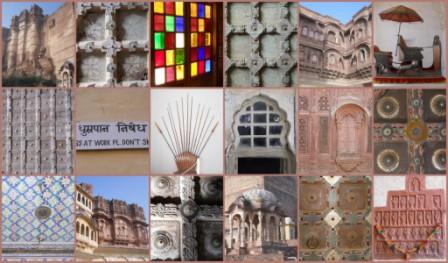Cooking Classes in Jodhpur.
We appear to have acquired our own, private tuk-tuk driver who will be wherever we need him to be whenever we need him. We didn’t ask for him, he just sort of happened. So far we have been on eight journeys. He’s waited for us while we’ve eaten and today we kept him waiting for 1 1/2 hours after the agreed time. As yet no money has changed hands and Lord Krishna alone knows how much this is going to cost us; but it’s great to be able to give the other drivers the brush off knowing that our man will be waiting, as agreed.
He’s had plenty to do today. After breakfast we headed for the Mehrangarh, the magnificent fort which dominates the skyline above Jodhpur and is reputed to be one of the finest in India. I’ve nothing to go on comparison wise but I can say that this is one damn fine fort. Huge doesn’t come into it and the detail in the stonework, painting, glass and studded doors is staggering. I uttered some exclamation or other at nearly every turn and having worked my way through crikey!, wow!, Oh My God! and ‘cut me off at the knees and call me stumpy!’ fairly quickly I had to go interfaith (oi! oi! oi!, Holy Mother of God), international (oh la la!, sacré bleu!) and finally historical (gadzooks! s’blood!) for fear of becoming repetitious).
Then we headed back into town for our first cooking class, more of which later. A flying visit to the hotel for an appetite reviving 50 lengths of the pool before heading back into town for cooking class number two and finally home to the hotel. Ye gods and little fishes! (My mother used to say that; I not even sure what it means) Our busiest day so far for sure.
So, two cooking classes, both with striking similarities and yet completely different. Both started with us learning about the medicinal properties of spices. This is the law in India. I have now spoken with 5 people about spices and all five have reeled off a list of spices along with their ability to heal wounds, prevent wind, aid digestion, freshen breath, cure cancer or give you the libido of a rutting stag and the staying power of a prize bull. Now I know where the verb to ginger thing up comes from; and it’s more literal that I ever would have thought. Madre de Dios!
On both classes we learnt how to make masala chai, vegetable biriyani, raita, and chapatti’s; which, by the way, are not just similar to rotis but the exact same thing. I know right? Incroyable! Actually, it seems they might actually be different after all, it depends who you talk to. Both classes are run by spice shops for which Jodphur seems to have become the global epicentre. This means we work a lot with blended spices. Good for them for finding a really convincing way of promoting their own spices but not so good for us hoping to learn about the first principles of Indian spicing. For both lessons we were taught by a woman. Aacha! that’s not the way we do things in these parts. (Enough already! with the exclamations. Ed.)
Here the experiences start to diverge a bit. Both classes are really informative and useful but it’s pretty obvious that one of our teachers is a good cook, with proven lesson plans, skilled at sharing her knowledge and able to answer questions intelligently. The other is making it up as she goes along, is not a skilled cook and answers questions with fairly stock answers. I get the impression that the second has jumped on the cooking class bandwagon but still has a way to go. The first on the other hand is genuinely delighted to be able to share her knowledge. This probably explains why, with no marketing expertise and only herself and her husband running the business (which is a spice and general store as well as the school), her classes are the second highest rated thing to do in Jodhpur after the fort.
I could easily now write reams about everything we learnt and I’ll try not to get carried away, but some things really stood out for me.
- Yoghurt is a big ingredient. We added it to bread, sauces, dressings and made a drink out of it. It could easily occur in every course of a meal.
- Saffron is also favoured a lot. Really top quality saffron is grown in Kashmir and it has a reputation for having remarkable medicinal qualities. Though still expensive here saffron is an essential.
- There are few hard and fast rules. Recipes are as varied as the colours of the textiles in the market. We made a raita which resembled a fruit salad, a biriyani that looked like a paella, and naan breads which could easily have passed for chapattis.
- Whilst we added some chilli to most dishes I wouldn’t describe any of them as hot; just warm.
- There’s no escaping the fact that it’s a pretty rich diet. To one dish we started by frying in ghee (lots) then added yoghurt, paneer and coconut.
If you find yourself in Jodhpur with just time for one cooking class then please go and see Rehka at Spice Paradise. You definitely learn a lot and you’ll certainly eat well.
Having done two classes in one day and eaten the produce of both we were barely capable of waddling out of the second. Luckily we didn’t have to waddle far as our trusty tuk-tuk was and mega-reliable driver were on hand to carry us, happily full of both food and new ideas, home to bed.






